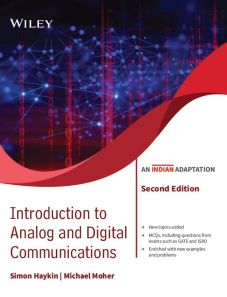Introduction to Analog and Digital Communications, 2ed (An Indian Adaptation)
ISBN: 9789354644337
672 pages
For more information write to us at: acadmktg@wiley.com

Description
Introduction to Analog and Digital Communications, second edition, offers up-to-date coverage on the principles of analog and digital communications, focusing on the fundamentals of communication theory and relating theory to practice. Adopting a “systems” perspective approach, the book focuses on the concepts of modulation theory, probability theory and signal detection, and the role of noise in communication systems. Numerous worked-out examples as well as theme examples have been included to help students develop an intuitive grasp of the theory.
Chapter 1 Introduction
1.1 Overview
1.2 Functional Elements of Communication Systems
1.3 Primary Resources and Operational Requirements
1.4 Underpinning Theories of Communication Systems
1.5 Applications
1.6 Concluding Remarks
Chapter 2 Fourier Representation of Signals and Systems
2.1 Fourier Series
2.2 The Fourier Transform
2.3 Properties of the Fourier Transform
2.4 The Inverse Relationship Between Time and Frequency
2.5 Dirac Delta Function
2.6 Fourier Transforms of Periodic Signals
2.7 Transmission of Signals Through Linear Systems: Convolution Revisited
2.8 Ideal Low-Pass Filters
2.9 Correlation and Spectral Density: Energy Signals
2.10 Power Spectral Density
2.11 Positive and Negative Frequencies
2.12 Hilbert Transform
2.13 Pre-Envelopes and Complex Envelopes of Band-Pass Signals
2.14 Complex Low-Pass Representations of Band-Pass Systems
2.15 Numerical Computation of the Fourier Transform
2.16 Summary and Discussion
Chapter 3 Amplitude Modulation
3.1 Amplitude Modulation
3.2 Virtues, Limitations, and Modifications of Amplitude Modulation
3.3 Double Sideband-Suppressed Carrier Modulation and Demodulation
3.4 Costas Receiver
3.5 Quadrature-Carrier Multiplexing
3.6 Single-Sideband Modulation and Demodulation
3.7 Vestigial Sideband Modulation and Demodulation
3.8 Baseband Representation of Modulated Waves and Band-Pass Filters
3.9 Theme Examples
3.10 Summary and Discussion
Chapter 4 Angle Modulation
4.1 Basic Definitions
4.2 Properties of Angle-Modulated Waves
4.3 Relationship Between PM and FM Waves
4.4 Narrow-Band Frequency Modulation
4.5 Wide-Band Frequency Modulation
4.6 Transmission Bandwidth of FM Waves
4.7 Generation of FM Waves
4.8 Demodulation of FM Signals
4.9 Theme Example: FM Stereo Multiplexing and FM Cellular Telephones
4.10 Summary and Discussion
Chapter 5 Pulse Modulation: Transition from Analog to Digital Communications
5.1 Sampling Process
5.2 Pulse-Amplitude Modulation
5.3 Pulse-Position Modulation
5.4 Completing the Transition from Analog to Digital
5.5 Quantization Process
5.6 Pulse-Code Modulation
5.7 Delta Modulation
5.8 Differential Pulse-Code Modulation
5.9 Line Codes
5.10 Theme Examples
5.11 Summary and Discussion
Chapter 6 Baseband Data Transmission
6.1 Baseband Transmission of Digital Data
6.2 The Intersymbol Interference Problem
6.3 The Nyquist Channel
6.4 Raised-Cosine Pulse Spectrum
6.5 Baseband Transmission of M-ary Data
6.6 The Eye Pattern
6.7 Computer Experiment: Eye Diagrams for Binary and Quaternary Systems
6.8 Theme Example: Equalization
6.9 Summary and Discussion
Chapter 7 Digital Band-Pass Modulation Techniques
7.1 Some Preliminaries
7.2 Geometric Representation of Signals
7.3 Gram–Schmidt Orthogonalization Procedure
7.4 Binary Amplitude-Shift Keying
7.5 Phase-Shift Keying
7.6 Frequency-Shift Keying
7.7 Summary of Three Binary Signaling Schemes
7.8 Noncoherent Digital Modulation Schemes
7.9 M-ary Digital Modulation Schemes
7.10 Mapping of Digitally Modulated Waveforms onto Constellations of Signal Points
7.11 Theme Examples
7.12 Summary and Discussion
Chapter 8 Probability, Random Processes, and Noise
8.1 Probability and Random Variables
8.2 Expectation
8.3 Transformation of Random Variables
8.4 Gaussian Random Variables
8.5 The Central Limit Theorem
8.6 Random Processes
8.7 Correlation of Random Processes
8.8 Spectra of Random Signals
8.9 Gaussian Processes
8.10 White Noise
8.11 Narrowband Noise
8.12 Summary and Discussion
Chapter 9 Noise in Analog Communications
9.1 Noise in Communication Systems
9.2 Signal-to-Noise Ratios
9.3 Band-Pass Receiver Structures
9.4 Noise in DSB-SC Receivers
9.5 Noise in AM Receivers Using Envelope Detection
9.6 Noise in SSB Receivers
9.7 Noise in FM Receivers
9.8 FM Pre-emphasis and De-emphasis
9.9 Summary and Discussion
Chapter 10 Noise in Digital Communications
10.1 Bit Error Rate
10.2 Detection of a Single Pulse in Noise
10.3 Optimum Receivers Using Coherent Detection
10.4 Optimum Detection of Binary PAM in Noise
10.5 Optimum Detection of BPSK
10.6 Detection of QPSK and QAM in Noise
10.7 Optimum Detection of Binary FSK
10.8 Differential Detection in Noise
10.9 Summary of Digital Performance
10.10 Error Detection and Correction
10.11 Summary and Discussion
Chapter 11 System and Noise Calculations
11.1 Electrical Noise
11.2 Noise Figure
11.3 Equivalent Noise Temperature
11.4 Cascade Connection of Two-Port Networks
11.5 Free-Space Link Calculations
11.6 Terrestrial Mobile Radio
11.7 Summary and Discussion
Additional Problems
Advanced Problems
Multiple Choice Questions
Answers to Drill Problems
Answers to Multiple Choice Questions
Appendix 1 Power Ratios and Decibel
Appendix 2 Bessel Functions
Appendix 3 The Q-function and Its Relationship to the Error Function
Appendix 4 Schwarz’s Inequality
Appendix 5 Mathematical Tables
Appendix 6 MATLAB Scripts for Computer Experiments to Problems in Chapters 6–10
Glossary
Bibliography
Index

